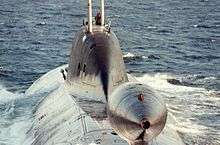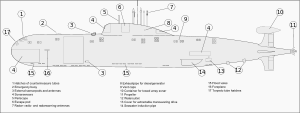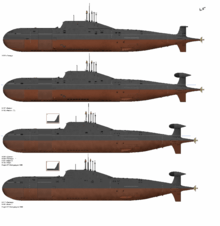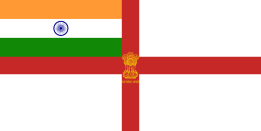Akula-class submarine
 | |
| Class overview | |
|---|---|
| Name: | Akula |
| Operators: | |
| Preceded by: |
|
| Succeeded by: | Yasen class |
| Cost: | est. $1.55 billion (1995 dollars) |
| In service: | 1984 |
| Planned: | 21 (6 later cancelled)[1] |
| Completed: | 15 |
| Active: | 10 (9 in Russia, 1 in India) |
| General characteristics | |
| Type: | Nuclear-powered attack submarine |
| Displacement: |
|
| Length: |
|
| Beam: | 13.6 m (45 ft) |
| Draught: | 9.7 m (32 ft) |
| Propulsion: |
|
| Speed: |
|
| Endurance: | 100 days[1] |
| Test depth: |
|
| Complement: | 73 for Akula I & Improved,[4] 62 (31 officers) for Akula II & III [5] |
| Sensors and processing systems: |
|
| Electronic warfare & decoys: | |
| Armament: | |
| Notes: | |
Project 971 Щука-Б (Shchuka-B, 'Shchuka' meaning "pike", NATO reporting name "Akula"), is a nuclear-powered attack submarine (SSN) first deployed by the Soviet Navy in 1986. The class is also known under the name Bars (meaning "snow leopard").[6] There are four sub-classes or flights of Shchuka, consisting of the original seven Akula Is, commissioned between 1984 and 1990; six Improved Akulas, commissioned between 1991 and 2009; one Akula II, commissioned in 1995; and one Akula III, commissioned in 2001. The Russians call all of the submarines Shchuka-B, regardless of modifications.[7]
Some potential for confusion may exist, as the name Akula (Акула meaning "shark" in Russian) was used by the Soviets for a different submarine, the Projekt 941 which is known in the West as the Typhoon class. By contrast, the Projekt 971 (the subject of this article) was named Shchuka-B by the Soviets but designated as the "Akula class" by the West after the name of the lead ship, K-284.
The launch of the first submarine in 1985, according to defense analyst Norman Polmar, "shook everyone [in the West] up", as Western intelligence agencies had not expected the Soviet Union to produce such a boat for another ten years.[8]
Construction
The Akula incorporates a double hull system composed of an inner pressure hull and an outer "light" hull. This allows more freedom in the design of the exterior hull shape, resulting in a submarine with more reserve buoyancy than its western analogs. This design requires more power than single-hull submarines because of the greater wetted surface area, which increases drag.
The distinctive "bulb" or "can" seen on top of the Akula's rudder houses its towed sonar array, when retracted. Most Akulas have the SOCKS hydrodynamic sensors, which detect changes in temperature and salinity. They are located on the leading edge of the sail, on the outer hull casing in front of the sail and on the bottom of the hull forward of the sail. All Akulas have two T-shaped doors on the aft bottom of the hull, on either side. These are where the OK-300 auxiliary propulsion devices are located, which can propel the submarine at up to 5 knots (9.3 km/h).

Akulas (excluding Nerpa) are armed with four 533 mm torpedo tubes which can use Type 53 torpedoes or the SS-N-15 Starfish missile, and four 650 mm torpedo tubes which can use Type 65 torpedoes or the SS-N-16 Stallion missile. These torpedo tubes are arranged in two rows of four tubes each. Improved Akulas, Akula IIs have an additional six 533 mm torpedo tubes mounted externally, capable of launching possibly up to 6 decoys each. The external tubes are mounted outside the pressure hull in one row, above the torpedo tubes, and can only be reloaded in port or with the assistance of a submarine tender. The 650 mm tubes can be fitted with liners to use the 533 mm weaponry. The submarine is also able to use its torpedo tubes to deploy mines.
Current status
As with many Soviet/Russian craft, information on the status of the Akula-class submarines is sparse, at best. Information provided by sources varies widely.
Akula-I (project 971)
Of the seven original Akulas, only three are known to still be in service. These boats are equipped with MGK-500 Skat sonar system (NATO reporting name Shark Gill).[9][10] The lead boat of the class, K-284 Akula was decommissioned in 2001, apparently to help save money in the cash-strapped Russian Navy. K-322 Kashalot and K-480 Bars [currently Ak Bars] are in reserve. K-480 Bars was put into reserve in 1998,[1] and is being dismantled in February 2010.[11] Pantera returned to service in January 2008 after a comprehensive overhaul.[12] All were retrofitted with the SOCKS hydrodynamic sensors. All submarines before K-391 Bratsk have reactor coolant scoops that are similar to the ones of the Typhoon-class SSBNs, long and tubular. Bratsk and subsequent submarines have reactor coolant scoops similar to the short ones on the Oscar IIs (the Typhoon, Akula and Oscar classes use the similar OK-650 reactor).
Akula I Improved (project 971 and 971I)
The six Akulas of this class are all thought to be in service. They are quieter than the original Akulas. The MGK-500 sonar is upgraded to MGK-501 Skat-MS. Sources also disagree as to whether construction of this class has been suspended, or if there are a further two units planned.
Improved Akula-I Hulls: K-328 Leopard, K-461 Volk, K-154 Tigr, K-419 Kuzbass, K-295 Samara and K-152 Nerpa. These submarines are much quieter than early Akula class submarines and all have the SOCKS hydrodynamic sensors except Leopard.[13] The Akula-I Improved submarines have 6 533 mm decoy launching tubes, as do subsequent submarines. They have a different arrangement of limber holes on the outer hull than Akula Is. Nerpa and Iribis (not completed) have a different rescue chamber in the sail, which can be distinguished by the large dome on the top surface.
Akula-II (project 971U)
K-157 Vepr is the only completed Akula II. The Akula II is 3 metres (9.8 ft) longer and displaces about 700 tons (submerged displacement) more than the Akula I. The added space was used for additional quieting measures. The MGK-501 Skat sonar system on Akula-I is replaced to a new MGK-540 Skat-3 sonar system.[14] K-157 Vepr became the first Soviet submarine that was quieter than the latest U.S. attack submarines of that time, which was the improved Los Angeles class (SSN 751 and later).[15] Two of these submarines were used to build the Borei-class SSBNs.
Akula-III (project 971M)
K-335 Gepard is the only completed Akula III (see table for others). There is no NATO classification for the AKULA III. It is longer and has a larger displacement compared to the Akula II. Also, it has an enlarged sail and a different towed-array dispenser on the vertical fin. Again, more noise reduction methods were employed. The Gepard was the most advanced Russian submarine before the submarines of the Severodvinsk and Borei classes were commissioned. One of this class was used to complete the Borei SSBNs.
The Soviet advances in sound quieting were of considerable concern to the West, for acoustics was long considered the most significant advantage in U.S. submarine technology compared to the Soviets.

In 1983–1984 the Japanese firm Toshiba sold sophisticated, nine axis milling equipment to the Soviets along with the computer control systems, which were developed by Norwegian firm Kongsberg Vaapenfabrik. U.S Navy officials and Congressmen announced that this technology enabled the Soviet submarine builders to produce more accurate and quieter propellers.[16]
Due to the breakup of the Soviet Union in 1991, production of all Akulas slowed.
The 1999–2000 edition of Jane's Fighting Ships incorrectly listed the first Akula-II as Viper (the actual name is "Vepr", "wild boar" in Russian), commissioned November 25, 1995. Gepard (Cheetah), launched 1999 and was commissioned 5 December 2001, and Nerpa, laid down in 1993,[1] began sea trials in October, 2008. It was commissioned by the Indian Navy as INS Chakra II in April 2012.[17]
Units
| # | Project | Name | NATO | Shipyard | Laid down | Launched | Commissioned | Status |
|---|---|---|---|---|---|---|---|---|
| K-284 | 971 | Akula | Akula I | Amur Shipyard | 6 November 1983 | 16 June 1984 | 30 December 1984 | Pacific Fleet. 2001 removed from service[18] |
| K-263 | 971 | Delfin | Akula I | Amur Shipyard | 9 May 1985 | 28 May 1986 | 30 December 1987 | Pacific Fleet, removed from active service, status unclear[18] |
| K-322 | 971 | Kashalot | Akula I | Amur Shipyard | 5 September 1986 | 18 July 1987 | 30 December 1988 | Pacific Fleet, removed from active service, to undergo overhaul and modernization.[18] Under Negotiation for lease to India [19] |
| K-480 | 971 | Ak Bars | Akula I | Sevmash | 22 February 1985 | 16 March 1988 | 31 December 1988 | Northern Fleet. Removed from service 1998.[18] Scrapping began February 2010.[11] |
| K-391 | 971 | Bratsk | Akula I | Amur Shipyard | 23 February 1988 | 14 April 1989 | 29 December 1989 | Pacific Fleet, removed from active service, to undergo overhaul and modernization.[20][21] |
| K-317 | 971 | Pantera | Akula I | Sevmash | 6 November 1986 | 21 May 1990 | 30 December 1990 | Northern Fleet[18] |
| K-331 | 971 | Magadan (ex Narval) |
Akula I | Amur Shipyard | 28 December 1989 | 23 June 1990 | 31 December 1990 | Pacific Fleet[18] Undergoing overhaul[22] |
| K-461 | 971 | Volk | Akula I Improved | Sevmash | 14 November 1987 | 11 June 1991 | 29 December 1991 | Northern Fleet[18] Undergoing overhaul [23] |
| K-328 | 971 | Leopard | Akula I Improved | Sevmash | 26 October 1988 | 28 June 1992 | 15 December 1992 | Northern Fleet[18] Overhaul underway since November 2011[24][25] |
| K-419 | 971 | Kuzbass | Akula I Improved | Amur Shipyard | 28 July 1991 | 18 May 1992 | 31 December 1992 | Pacific Fleet, under repair since 2010[7][26] Overhaul completed by December 2015[22][27] |
| K-154 | 971 | Tigr | Akula I Improved | Sevmash | 10 September 1989 | 26 June 1993 | 29 December 1993 | Northern Fleet[18] Overhaul underway since September 2011[25] |
| K-295 | 971 | Samara | Akula II | Amur Shipyard | 7 November 1993 | 5 August 1994 | 28 July 1995 | Pacific Fleet[18] To undergo overhaul and modernization[21] |
| K-157 | 971 | Vepr | Akula II | Sevmash | 13 July 1990 | 10 December 1994 | 25 November 1995 | Northern Fleet[18] Undergoing overhaul[23] |
| K-335 | 971 M | Gepard | Akula III | Sevmash | 23 September 1991 | 17 September 1999 | 5 December 2001 | Northern Fleet[18] Overhaul completed in November 2015[28][29] |
| K-337 | 971U | Kuguar | Akula II | Sevmash | 18 August 1992 | x | x | Not completed. Hull used for Yuri Dolgorukiy SSBN[18] (project 955 Borei) |
| K-333 | 971U | Rys | Akula II | Sevmash | 31 August 1993 | x | x | Not completed. Hull used for Alexander Nevsky SSBN[18] (project 955 Borei) |
| K-152 | 971I/09719 | Nerpa/ INS Chakra |
Akula II[30][31] | Amur Shipyard | 1993 | 4 July 2006 | 28 December 2009 | Pacific Fleet. Has been leased to India from the end 2012 to 2022.[32] |
| K-xxx | 971M | not named | Akula II | Sevmash | 1992 | x | x | Not Completed. Hull used for Vladimir Monomakh SSBN[18] (project 955 Borei) |
| K-xxx | 971I/09719 | Iribis | Akula I Improved | Amur Shipyard | 1994 | Nov-2016 | July-2017 | Construction halted at 60% completion. May be completed and leased to India, possibly joining the Indian Navy Q1 2022.[19][33][34][35] |
| K-xxx | 971M | not named | Akula II | Amur Shipyard | 1990 | x | x | Sold for scrap[18] |
| K-xxx | 971M | not named | Akula II | Amur Shipyard | 1991 | x | x | Sold for scrap[18] |
Lease to India
Three hundred Indian Navy personnel were trained in Russia for the operation of the Akula II submarine Nerpa. India has finalized a deal with Russia, in which at the end of the lease of these submarines, it has an option to buy them. The submarine is named INS Chakra as was the previous India-leased Soviet Charlie-I SSGN.[36] Chakra was officially commissioned into the Indian Navy on April 4, 2012.[37][38]
Whereas the Russian Navy's Akula-II could be equipped with 28 nuclear-capable cruise missiles with a striking range of 3,000 km (1,620 nmi; 1,864 mi), the Indian version is reportedly armed with the 300 km (162 nmi; 186 mi)-range Club-S nuclear-capable missiles.[39] Missiles with ranges greater than 300 km (162 nmi; 186 mi) cannot be exported due to arms control restrictions, since Russia is a signatory to the MTCR treaty.
Russia said in December 2014 that it is ready to lease India more nuclear-powered submarines a day after President Vladimir Putin and Prime Minister Narendra Modi pledged to deepen defence ties.[40]
In January 2015, it was reported that India was involved in negotiations involving the leasing of the Kashalot and the Iribis.[19] An agreement was reportedly reached in October 2016.[33][41]
Nerpa 2008 accident
On 27 October 2008, it was reported that K-152 Nerpa of the Russian Pacific Fleet had begun her sea trials in the Sea of Japan before handover under a lease agreement to the Indian Navy.[42] On 8 November 2008, while conducting one of these trials, an accidental activation of the halon-based fire-extinguishing system took place in the fore section of the vessel. Within seconds the halon gas had displaced all breathable air from the compartment. As a result, 20 people (17 civilians and 3 seamen)[43][44] were killed by asphyxiation. Dozens of others suffered freon-related injuries and were evacuated to an unknown port in Primorsky Krai.[45] This was the worst accident in the Russian navy since the loss of the submarine K-141 Kursk in 2000. The submarine itself did not sustain any serious damage and there was no release of radiation.[46]
Recent overseas deployments
In August 2009, the news media reported that two Akula-class submarines operated off the East Coast of the United States, with one of the submarines being identified as a Project 971 Shchuka-B type. U.S. military sources noted that this was the first known Russian submarine deployment to the western Atlantic since the end of the Cold War, raising concerns within U.S. military and intelligence communities.[47] The U.S. Northern Command confirmed that this 2009 Akula-class submarine deployment did occur.[48]
In August 2012, the news media reported that another Akula-class submarine operated in the Gulf of Mexico purportedly undetected for over a month, sparking controversy within U.S. military and political circles, with U.S. Senator John Cornyn of the Senate Armed Services Committee demanding details of this deployment from Admiral Jonathan W. Greenert, the Chief of Naval Operations.[49]
References
- 1 2 3 4 Podvodnye Lodki, Yu.V. Apalkov, Sankt Peterburg, 2003, ISBN 5-8172-0070-8
- ↑ Jane's Fighting Ships 2008-09, p644
- ↑ 28.01.2010 (2010-01-28). "The Ship Day to be celebrated at SSN Kuzbass". Rusnavy.com. Retrieved 2012-10-04.
- ↑ Specification: SSN Akula Class (Bars Type 971) Attack Submarine, Russia, www.naval-technology.com, archived from the original on 2011-06-05
- ↑ "Typhoon (Akula) class (Project 941/941U) (Russian Federation) - Jane's Fighting Ships". Articles.janes.com. 2012-07-24. Retrieved 2012-10-04.
- ↑ John Pike. "Akula Class / Bars-class / Project 971". Globalsecurity.org. Retrieved 2012-10-04.
- 1 2 "In-service ships". Rusnavy.com. Retrieved 2012-10-04.
- ↑ Norman, Colin (31 March 1989). "Quiet Soviet Subs Prompt Concern". Science. American Association for the Advancement of Science. 243 (4899): 1653. JSTOR 1703462. (subscription required (help)).
- ↑ "MGK-500 Shark Gill (Bow)". Harpoondatabases.com. Retrieved 2012-10-04.
- ↑ "Armament "MGK-500" automated sonar complex". Submarine.su. Archived from the original on 2012-10-18. Retrieved 2012-10-04.
- 1 2 "Incendie à bord d'un sous-marin nucléaire russe désaffecté | Russie | RIA Novosti". Fr.rian.ru. 2010-02-19. Retrieved 2012-10-04.
- ↑ "K-317 Pantera". Rusnavy.com. Retrieved 2012-10-04.
- ↑ "Run Silent, Run Deep - Navy Ships". Fas.org. Retrieved 2012-10-04.
- ↑ "Armament "MGK-540" automated sonar complex". Submarine.su. Archived from the original on 2012-10-18. Retrieved 2012-10-04.
- ↑ Adm. Boorda, statement at a meeting of the Naval & Maritime Correspondents Circle, Washington, D.C. 27 Feb 1995
- ↑ "Quieter Soviet subs cost U.S. at least $30 billion", Navy News & Undersea Technology (14 March 1988)
- ↑ "Russian-built nuclear submarine joins Indian navy". BBC News. 4 April 2012. Retrieved 3 October 2013.
- 1 2 3 4 5 6 7 8 9 10 11 12 13 14 15 16 17 Korabli VMF SSSR, Vol. 1, Part 2, Yu. Apalkov, Sankt Peterburg, 2003, ISBN 5-8172-0072-4
- 1 2 3 "India to lease Russian nuclear submarine "Кашалот" (Kashalot / Sperm Whale)". 20 Jan 2015.
- ↑ "Шойгу потребовал изменить порядок финансирования ремонта на флоте". РИА Новости. Retrieved 19 December 2014.
- 1 2 "Russia Releases Photos of its Submarine Fleet". Defense Tech. Retrieved 19 December 2014.
- 1 2 http://www.janes.com/article/54981/russia-details-ambitious-effort-to-modernise-nuclear-powered-submarines-to-bolster-order-of-battle
- 1 2 http://www.janes.com/article/59030/russian-project-971-submarines-to-be-armed-with-kalibr-missiles
- ↑ 24.11.2011 (2011-11-24). "SSN Voronezh Passed Modernization". Rusnavy.com. Retrieved 2011-12-28.
- 1 2 http://indias-defence.blogspot.hr/2015/03/complete-information-on-indias-second_31.html
- ↑ "Three Russian Nuke Subs to Be Recommissioned in 2013". Retrieved 19 December 2014.
- ↑ http://rushincrash.com/forces/nuclear-submarine-kuzbass-returns-to-the-fleet-until-the-new-year/
- ↑ http://function.mil.ru/news_page/country/more.htm?id=12067485@egNews
- ↑ http://sputniknews.com/military/20151128/1030903487/russia-gepard-submarine.html
- ↑ "Russia Hands Over Nerpa Nuclear Sub to India | Defense | RIA Novosti". En.rian.ru. 2012-01-23. Retrieved 2012-10-04.
- ↑ 4/10/2012 22:35 (2009-07-29). "K-152 Nerpa: Russian Akula II class nuclear attack submarine | INFOgraphics | RIA Novosti". En.rian.ru. Retrieved 2012-10-04.
- 1 2 http://www.janes.com/article/64913/india-to-lease-second-russian-akula-class-ssn?from_rss=1&hootPostID=263d5166e2fa62a8f68d64c402f88ab4
- ↑ Vladimir Radyuhin. "India in talks with Russia on lease of second nuclear submarine". The Hindu. Retrieved 2013-03-15.
- ↑ "India Interested in Leasing Second Russian Nuclear Attack Sub". USNI News. Retrieved 19 December 2014.
- ↑ "India to get Russian nuclear submarine after 17 years". Retrieved 19 December 2014.
- ↑ "INS Chakra: Govt inducts Russian-origin Akula II class Nerpa into Navy - The Economic Times". Economictimes.indiatimes.com. 2012-04-04. Retrieved 2012-10-04.
- ↑ "INS Chakra formally inducted into Indian Navy : South, News - India Today". Indiatoday.intoday.in. 2012-04-04. Retrieved 2012-10-04.
- ↑ "Russia may lease nuclear submarine to India". The Hindu. Chennai, India. 1 July 2006.
- ↑ Natalie Obiko Pearson, Anurag Kotoky (12 Dec 2014). "Putin ready to lease nuclear submarines to India, minister says". Bloomberg. Retrieved 14 December 2014.
- ↑ https://sputniknews.com/military/201607121042804814-russian-navy-akula-sub/
- ↑ "Russia's new nuclear attack submarine starts sea trials | Russia | RIA Novosti". En.rian.ru. 2008-10-27. Retrieved 2012-10-04.
- ↑ "Accident on nuclear submarine kills 20 off eastern Russian coast". International Herald Tribune. 2008-11-09. Archived from the original on 26 November 2008. Retrieved 9 November 2008.
Seventeen civilians and three seamen died in the accident and 21 others were hospitalized after being evacuated to a destroyer that brought them to shore, Markin said in a statement.
- ↑ "Twenty dead in Russian nuclear submarine accident". RIA Novosti. 2008-11-09. Retrieved 9 November 2008.
Russia's Investigative Committee earlier said the nuclear submarine incident killed 20, including three sailors and 17 shipyard workers, while 22 people were injured.
- ↑ "Over 20 killed in Russian submarine accident | Russia | RIA Novosti". En.rian.ru. 2000-08-12. Retrieved 2012-10-04.
- ↑ "Accident on Russian Nuclear Submarine Kills 20". Reuters. Retrieved 2008-11-09.
More than 20 people were killed and another 21 injured in an accident aboard a Russian nuclear submarine in the Pacific Ocean, the navy said on Sunday, in the worst submarine disaster since the Kursk sank eight years ago.
- ↑ "Russian Subs Patrolling Off East Coast of U.S.". New York Times. August 2, 2012. Retrieved 2012-10-04.
A pair of nuclear-powered Russian attack submarines has been patrolling off the eastern seaboard of the United States in recent days, a rare mission that has raised concerns inside the Pentagon and intelligence agencies about a more assertive stance by the Russian military.
; Mark, Mazzette; Thom Shanker (August 6, 2009). "Pentagon: Russian subs no cause for alarm". UPI. Retrieved 2012-10-04.The presence of two Russian submarines seen cruising off America's East Coast should not be cause for alarm, the U.S. Defense Department said.
; and "Two Russian Nuclear Submarines Make USA Shake With Fear". Pravda. August 8, 2009. Retrieved 2012-10-04.Two Russian nuclear submarines have been patrolling the USA’s East Coast during the recent several days, The New York Times wrote. One of the submarines was detected Tuesday about 200 miles off the US coast, anonymous sources at the Pentagon said.
- ↑ Phillip Ewing (August 20, 2012). "Pentagon Denies Russian Sub Patrolled Gulf of Mexico". News and Analysis. United States Naval Institute. Retrieved 2012-10-04.
- ↑ Gertz, Bill (August 14, 2012). "Silent Running". Washington Free Beacon. Retrieved 2012-10-04.
A Russian nuclear-powered attack submarine armed with long-range cruise missiles operated undetected in the Gulf of Mexico for several weeks and its travel in strategic U.S. waters was only confirmed after it left the region, the Washington Free Beacon has learned.
; Gertz, Bill (August 21, 2012). "Torpedo Run". Washington Free Beacon. Retrieved 2012-10-04.A member of the Senate Armed Services Committee has asked the Navy’s top admiral to explain reports that a Russian submarine operated undetected in the Gulf of Mexico recently.
; "Reports of Russian sub in gulf downplayed". UPI. August 19, 2012. Retrieved 2012-10-04.Russia declined to confirm or deny a media report that one of its submarines spent a month in the Gulf of Mexico without the knowledge of the United States.
; and "Russian submarine sailed incognito along the coast of the U.S.". Pravda. August 21, 2012. Retrieved 2012-10-04.A Russian nuclear submarine of project 971 ("Jaws", in NATO classification), armed with long-range cruise missiles, sailed for a long time without being detected in the waters along the U.S. coastline, the Gulf of Mexico, informs the Washington Free Beacon, citing an unnamed U.S. official.
External links
| Wikimedia Commons has media related to Akula class submarines. |
- Akula Class - Project 971 at FAS.org
- Description of the class (as of 1999) at "SUBSIM Review"
- Details of the Akula class (and others) at "Hazegray"


